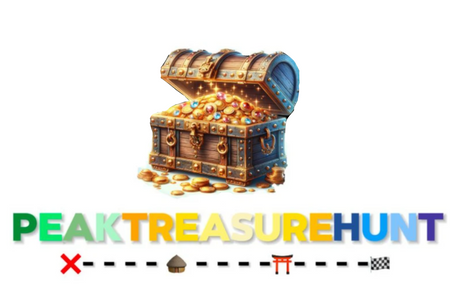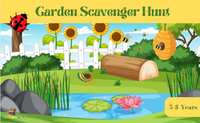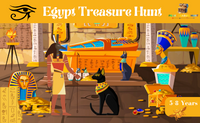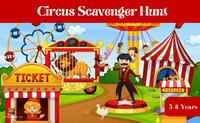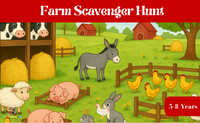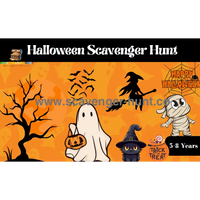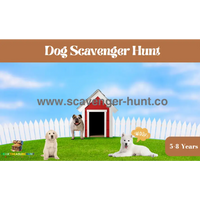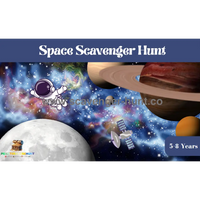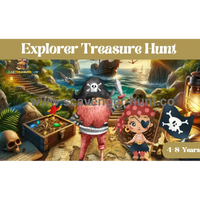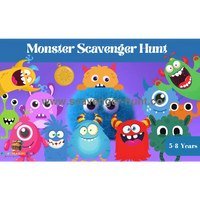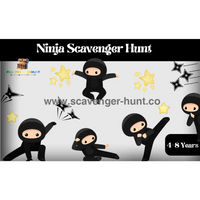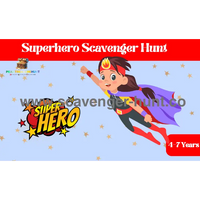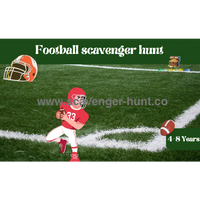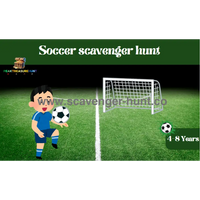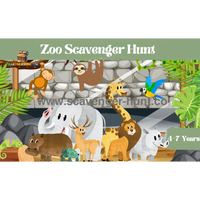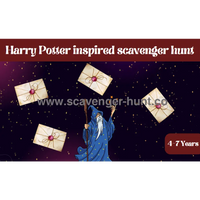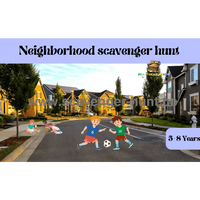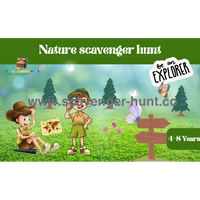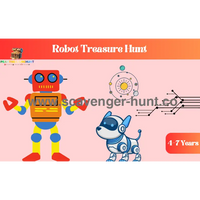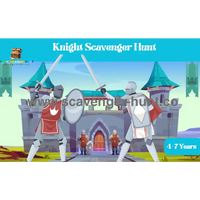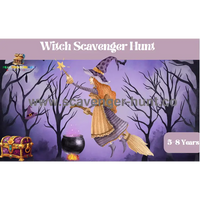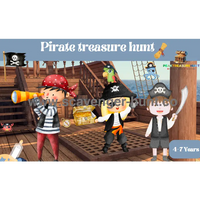Planning the Perfect Scavenger Hunt or Treasure Hunt
Scavenger hunts and treasure hunts make for amazing team building activities, memorable parties, or just fun adventures with family and friends. But organizing a successful hunt takes some planning and creativity. Here are the answers to the most frequently asked questions when putting together these interactive events:
How Do You Plan And Organize A Hunt?
The first step in putting together a successful scavenger hunt or treasure hunt is nailing down the key planning details. Without a solid organizational blueprint, your hunt can quickly become a chaotic mess. Here are the essential elements to map out from the start:
Determine Your Goals & Objectives
What is the main purpose behind running this hunt? That will dictate many of the decisions you make throughout the planning process. Common objectives include:
Team Building - If using for team building at work, school, etc. you'll want to emphasize activities that require collaboration, communication, and working together.
Celebrating an Occasion - Hunts are great for birthdays, holidays, graduations, and other celebrations. The theme and locations may connect to the event being commemorated.
Education - When designed for learning, the clues and tasks can reinforce specific subjects, skills, or knowledge areas in a creative, engaging way.
Pure Entertainment - Many hunts are just for fun, laughs, and excitement without an overarching objective beyond stimulating social interaction and friendly competition.
Define the Setting & Scope
Will your hunt take place in a single, confined location like an office, school, park, or neighborhood? Or perhaps across a wider area like an entire city, campus, or multi-state region? Determining the geographic scope will shape how scattered or concentrated your clues and route need to be.
For single locations, thoroughly inspect and map out the grounds to pinpoint potential clue spots, hazards, off-limit areas, and traffic patterns. For hunts spanning a wider radius, decide transportation methods and specify boundaries, especially near any unsafe zones.
Choose a Cohesive Theme
While not a must, having an overarching theme helps organize your hunt around a specific premise, setting, or subject. It allows you to craft more creative and immersive clues while giving participants a unifying narrative thread.
Possible themes include:
- Pirate
- Fantasy
- Princess/Fairytale
- Dinosaur
- Harry Potter
- Aladdin
- Nature
You can loosely or strictly tie the theme into locations, tasks, clues, and stories revealed throughout the hunt.
Mix Up Clue & Task Types
Don't just rely on one style of clue like riddles or trivia. The best hunts incorporate a diverse array of clue types to accommodateall learning styles and skills. Common options include:
Riddles/Wordplay - Play on words and double meanings Puzzles - Crosswords, crypto-grams, visual puzzles
Trivia - General knowledge across categories Picture/Visual Clues - Identifying people, objects, or scenery
Codes/Ciphers - Encoded messages players must decipher Locational - Descriptions pointing to a place, set of GPS coordinates Scavenger "Find"
Tasks - Obtain/bring back specific items
Physical Challenges - Obstacle courses, relays, challenges
By combining clues that are sedentary vs. active, mental vs. physical, simple vs. complex, you'll prevent players from getting burned out.
Plot a Logical Route & Clue Flow
Lay out the full sequence of clues or identifiable clue "zones" on a map. How will teams progress from start to finish? Is there a single prescribed path or can teams choose their route?
For stationary hunts, you want an intuitive flow and sensible locations building up to a final destination. Regional hunts may use a hub-and-spoke layout with paths branching from central areas. Try to minimize wildly crisscrossing or backtracking as much as possible.
Some hunts use portable clues where teams solve one clue to receive the next in sequential order. Others have locational clues pointing players toward fixed locations to pick up the next part of the trail.
Whichever approach you use, your clue trail needs logical order and progression. Avoid having location or objectives that send teams looping aimlessly. Include rest or supply stops en route for regional hunts.
Set Clear Rules & Determine Materials
Like any organized event, you need to establish rules and parameters for your hunt before teams take off. A few key rules to account for:
Time Limits - Give a maximum duration for the full hunt and/or time limits for reaching checkpoints or supplying clues.
Allowed Resources - Can players use phones, maps, internet, etc. Or must they rely solely on their brainpower and materials you provide?
Team Penalties - Consequences for breaking rules, off-limit areas, intentionally misleading clues/responses, etc.
Transportation Specifics - Permitted transportation methods, parking details, between location travel rules, etc.
Off-Limit Areas - Clearly define areas that are strictly off-limits and borders like water hazards, private property, roads etc.
In your planning materials for teams, include a list of any essential hunt materials they'll need like notepads, pencils/pens, flashlights, compasses, etc. You can provide some materials or have teams bring their own.
Test Run Your Hunt
Once you've created all the clues, established the path, and set the rules, do a full test run before going live with real participants. Ideally, have two separate groups complete the practice run to better pinpoint potential hiccups or bottlenecks.
Pay attention to areas where clues seem too confusing or vague. Note any overly challenging obstacles. Check that the intended time limits and route are realistic based on your test teams' completion times. If issues arise, adjust clues or rules before finalizing the hunt.
These key planning elements of establishing goals, scope, structure, and rules provide the organizational foundation for executing a sharp, professional-level scavenger hunt or treasure hunt. With these pieces solidly in place, you're ready to let the games begin! The next chapters will cover specific tips for developing creative clue content and unique connective narratives.
Discover our Complete Scavenger Hunts Collection.



What Are Creative Clue Ideas?
Coming up with an assortment of inventive and stimulating clues is the creative centerpiece of any scavenger hunt or treasure hunt. While straightforward questions can certainly be incorporated, the most engaging hunts weave in puzzle-style clues that make participants put on their thinking caps. Here are some creative clue formats to consider:
Wordplay & Rhyming Riddles
Tap into your playful linguistics skills by crafting clues with puns, double meanings, rhymes, and other entertaining wordplay. These clues tend to be reading comprehension-focused and can span various difficulty levels depending on how overt or obscure the hints are.
Example Rhyming Riddle: "At this garden site, you'll take a pleasant stroll, But don't let a super _______ ________ make you lose your soul!" (Solution: Hot Greenhouse; next clue location is a botanical garden's greenhouse)
Codes, Ciphers & Encryption
Humans have been making and breaking codes for millenia, fueling the imagination toward secret communications and clandestine operations. You can add an air of mystery and low-tech espionage by requiring players to decode encrypted clue texts using ciphers, symbol substitutions, or various cryptography methods.
Example: "OHZZRFTHQNBQWBVNHFRQNGUVNLUVBHIZB" (Solution: MEET TEAM AT SCIENCE MUSEUM; encoded in Atbash cipher)
Trivia & Puzzles
While trivia questions can be hit-or-miss, integrating diverse brain teasers and puzzles enables you to incorporate all sorts of academic subjects and intellectual challenges as clues. Use riddles, logic problems, visual and spatial reasoning, basic math, crosswords, pattern recognition, and moreNot all players will excel at every type, allowing collaboration.
Example Puzzle: "In this ancient civilization, some years had 13 months, and there were only 20 days in a week. If the year began on a Caban day, and a ceremony was held every 52nd day afterwards, how many ceremonies would there be during a year of 365 days?" (Solution: 7 ceremonies, relating to the Maya calendar system)
Visual & Picture Clues
For more visceral, creative thinking, incorporate visual-based clues that require players to examine details within photos, identify objects or architecture, and pull out key details. You can blur, redact, or partially obscure pictures to make solutions more challenging to discern. Shapes, logos, landmarks, and other distinctive iconography also make good visual clue fodder.
Example Visual Clue: "Name the famous fountain located between the two structures seen in this picture." (Image shows background views of the Lincoln Memorial and Washington Monument)
Challenges, Tasks & Scavengers
Kick the engagement into an even more participatory gear by building interactive tasks and challenges directly into your clues. Physical obstacles like relays, mazes, or equipment-gathering can add an extra spirit of competition and camaraderie. Or keep things more mentally demanding with complex brainteasers or creative prompts participants must tackle.
Example Task Clue:
"As a team, come up with a cohesive 1-minute comedic performance centered around the theme of penguins. Have it prepared for your next checkpoint judge."
Locational & Mapping Clues
For hunts spanning a considerable area, you can weave in location-based clues that guide teams toward their next destination using descriptive physical details or coordinates. GPS, geocaching concepts, and mapping skills come into play for both stationary and roaming hunts.
Example Locational Clue: "Coordinates for Location #4: N 34° 03.938' W 118° 14.726' — Follow the path off Riverside Drive toward the idyllic rose garden adjacent to the golf course."
Sequential & Prop-Based Clues
Instead of concealing clues across multiple locations, some hunts provide portable sets of clues to teams, with one feeding sequentially into the next. Incorporating actual props and physical item hunts can reinforce this sort of scavenger mission premise.
Example Prop-Based Clue: "Your next clue lies within the object you retrieved from the old oak's hallowed chamber." (Players must inspect an antique box obtained earlier for a slip of paper containing their next clue)
These creative clue formats go far beyond basic Q&A models, tapping into cognitive abilities like deduction, imagination, problem-solving, and hands-on skills. By incorporating a clever combination of these various clue styles throughout your hunt, you'll keep participants of all skillsets engaged, challenged, and eagerly awaiting each new brainteaser that awaits!

What Are The Best Locations?
When selecting a location (or series of locations) to host your scavenger hunt or treasure hunt, the possibilities are wide open. Both indoor and outdoor venues can provide exciting settings for the adventure to unfold. Here are some prime location options to consider along with key planning factors:
Indoor Venues
For hunts taking place primarily under one roof, some ideal indoor locations include:
Offices/Workplaces - Tap into the familiarity of your company's workplace for team building hunts. Incorporate fun clues connected to office personalities, branding, and culture.
Museums/Galleries - The artifacts, exhibits, and artwork provide ample opportunities for creative clues covering topics like history, science, and art. Many museums also have spaces available to rent for events.
Malls/Shopping Centers - These consumer havens allow you to map out hunts spanning stores, kiosks, amenities, and the retail labyrinth itself as one overarching venue.
Community Centers - Schools, recreation facilities, and other local centers offer versatile spaces and rooms to facilitate hunts on a smaller scale.
Hotels/Resorts - Plan a hunt as an entertaining activity for conferences, reunions, and retreats held at hotel properties with their lobbies, restaurants, and meeting rooms utilized.
When selecting an indoor site, be sure to secure proper permits or permission from venue managers. Inspect for any hazards and clearly designate off-limit areas. Having parking available and proximity to bathrooms is also convenient.
Outdoor Venues
If you prefer giving your hunt an open-air feel, consider these outdoor location opportunities:
Public Parks - Grassy fields, trails, playgrounds, gardens, and picnic areas make parks perfect for hunts with younger participants or physical challenge components.
College/Corporate Campuses - Take advantage of the mix of buildings, quads, sporting facilities, and landmarks found on most comprehensive campuses.
City Streets/Neighborhoods - With a walkable scope and distinct boundaries, hunts can be mapped throughout city blocks incorporating cool street art, local businesses, and key attractions.
Resorts & Theme Parks - Build the hunt around the rides, restaurants, shops, and amusements found in self-contained outdoor entertainment resorts or theme parks.
For outdoor venues, pay close attention to keeping players within designated hunting boundaries for safety and security. Make sure to obtain any necessary permits from local parks/rec departments or municipal offices.
Centralized vs Zonal Approach Depending on the size and layout of your location(s), you can set up your scavenger hunt as either centralized around one area or "zoned" across multiple regions. Centralized hunts keep all the action confined to the grounds of a single park, neighborhood, or defined space.
Zonal hunts are better suited for larger-scale adventures across cities or expansive campuses/resorts where you designate clues and checkpoints within distinct zones that teams rotate through. This divides the hunt into more manageable sections.
Ideal Location Characteristics
No matter your specific locale, some characteristics to look for include:
- Areas with significance or connection to participants/theme
- Accessibility for all ages/ability levels
- Parking, bathrooms, and transportation accommodations
- Options for adding interactive outdoor activities or indoors as needed
- Picturesque landmarks, art, architecture, or photo-worthy scenery
- Controlled crowding/capacity to avoid interference or safety issues
With some creative planning, you can craft an unforgettable scavenger hunt or treasure hunt experience at just about any location - traditional or outside-the-box! The most meaningful destinations will tie back to the goals and themes of the overall hunt while providing an engaging, secure environment for players. So scout those venues and get mapping!
Discover our Complete Scavenger Hunts Collection.


Making Clues For Different Ages/Levels?
One of the biggest challenges in designing a scavenger hunt or treasure hunt is creating clues that are accessible and engaging for all ages and skill levels involved. You want to strike the right balance of making things thought-provoking yet not frustratingly difficult. Here are some strategies for adjusting clue difficulties:
Clues for Younger Kids
When you have younger children (under 10 years old) participating, you'll want to keep clues fairly straightforward with simple language and overt hints. Fun rhyming riddles, visual/picture clues, and basic puzzles tend to work best.
Example Kid-Friendly Clue: "I'm brown, have a trunk, and a really long snout! Stomp, stomp, here I come with my ear-flapping shout!" (Solution: Elephant; Next location is the zoo's elephant habitat)
You can incorporate letters, numbers, shapes, colors, and simple word/pattern recognition into clues for this age group as well. To keep kids engaged, alternate physical challenges like scavenger item hunts and obstacle courses between brainteaser clues.
Pre-Teen & Teen Clues
As kids progress into pre-teen and teen ages, you can start ramping up clue difficulty with more abstract reasoning, code breaking, and skill-testing puzzles/tasks. However, you'll still want to avoid too many obscure prerequisite knowledge requirements.
Example Pre-Teen Clue: "If you have 9 cards in your hand, made up of 4 suits of 13 ranks each, but you only need 5 cards for the final trick...how many unique 5-card hands are possible?" (Solution: 63,612 unique 5-card hands from a 52-card deck)
Trivia clues with topics around pop culture, history, sports, and core subjects work well here. Feel free to integrate longer narrative and descriptive passages for reading comprehension challenges too.
Adult & Advanced Clues
For adult participants, you can really kick the difficulty into high gear with sophisticated clues and challenges requiring refined problem-solving abilities. Draw upon advanced linguistics, cryptography, and niche academic concepts.
Example Challenging Clue: "Looking at the symbolic logic notation for the conditional statement:
[(P ⥽ Q) ⥰ (¬R ⥽ S)] What is the complete truth table and corresponding Boolean expression?"
You can delve into complex trivia categories like collegiate-level subject material and mentally-strenuous brainteasers. Hands-on challenges that blend physical and mental elements, like completing mini engineering prototypes, multi-step labs, or capturing specific data readings, add extra layers too.
For hunts spread across large regions or cities, incorporate mapping, navigation, and geographic reasoning as part of your higher-level clues. Using historical, architectural, and cultural details to deduce locations is also fair game.
If your event involves mixed age groups, you can creatively present multi-level clues with easier "Option A" versions alongside the advanced "Option B" alternatives. Allowing teams to collaborate and work together is another way different skill levels can complement each other.
The key is making sure no single age or ability level gets completely stumped or breezes through too easily. With some creative calibrating tailored to your audience's dynamics, you can put together clues that prove gratifying for everyone involved!

Prize Ideas for Winners?
Having desirable prizes or rewards waiting for scavenger hunt and treasure hunt winners at the finish line helps up the anticipation and competitive excitement. While the bragging rights and pride of victory are great on their own, thoughtful awarded prizes add extra incentive that motivates peak performance.
When selecting prizes, account for your event's overall budget, the number of participants, and any specific themes or objectives. Group prizes that go to entire teams tend to make more sense, though you could consider also tacking on special individual prizes for top scorers or standout performances.
Here are some fun prize ideas to incentivize those hunting efforts across different budgets:
Lower Cost Options
Awards/Trophies - Simple plaques, medals, certificates
Wearables - Themed apparel like t-shirts, hats, socks
Event Swag - Customized mugs, stickers, memorabilia
Gift Cards - Popular restaurants, stores, streamers
Snacks/Treats - Candy assortments, cookie tins, trail mixes
Mid-Tier Prizes
Tickets - Movies, amusement parks, concerts or shows Tech
Accessories - Headphones, speakers, cord organizers
Game Night - Board games, trivia sets, puzzles
Sports Equipment - Balls, outdoor games, fitness gear
Gift Baskets - Curated assortments with a unifying theme
Higher Value Prizes
- Tablets/E-Readers
- Gaming Consoles/VR Headsets
- Smart Wearables/Home Tech Products
- Vacation Packages/Travel Vouchers
- High-End Merchandise/Memorabilia
- Cold Hard Cash (Pot to Split)
If your budget is more constrained, you can supplement smaller prizes by tying them to the hunt theme in clever ways. Tailor items to the interests and demographics of your participants.
You can also consider awarding prizes during the hunt itself rather than waiting until the finale. Checkpoints, challenges, or timed milestones provide opportunities to hand out periodic "mini prizes" to teams as bonus goals throughout the adventure. These can be smaller-value rewards like candy, gift cards, or knick-knacks that help sustain participants' drive.
Award ceremonies, creative prize presentation displays, and scoring breakdowns all help add an element of achievement and fanfare once the hunt concludes. Make the most of recognizing winners' accomplishments! Regardless of budget, putting thought into relevant prizes is a memorable way to energize your scavenger/treasure hunt and incentivize peak puzzle-solving performance.
Safety And Boundaries?
When you have groups running around during scavenger hunts and treasure hunts, safety needs to be the top priority for event organizers and coordinators. Without proper precautions and rule enforcement, you run the risk of participants wandering into restricted areas, injuring themselves, or disrupting others.
To keep everyone accounted for and playing responsibly, be crystal clear about event boundaries and safety protocols from the outset. Cover these key boundary and safety elements:
Define Geographical Boundaries
Provide a clear map with unambiguous marked boundaries indicating where teams are permitted to search and travel within during the hunt. Specify any prohibited areas that are strictly off-limits such as:
- Bodies of water
- Private properties
- Construction zones
- Roadways
- Restricted buildings/facilities
Bold lines, colorations, and textual call-outs help clarify boundary lines. For larger scale hunts across neighborhoods or regions, list specific address ranges rather than vague area descriptions. You can include small buffer areas beyond main boundaries rather than hard cut-offs.
Time Limits & Curfew
In addition to geographic constraints, implement time limits and fixed start/end times to keep participants from wandering endlessly. Set interim checkpoint times and a hard curfew for finishing the full hunt by a certain cut-off.
Have systems in place to track teams' locations and progress. For longer hunts, designate pre-determined times when new clues or route adjustments will be provided to keep folks moving. Make it clear you'll have staff enforcing time cut-offs.
Supervision Requirements
Any participants under a certain age need direct supervision from designated adult leaders, staff members, or parents/guardians at all times. Establish kid-to-adult ratios if separating into teams.
For corporate or student hunts, make it mandatory for teams to have an administrator, teacher, or senior team lead managing each group's efforts. Roaming event staff should periodically check on teams as well.
Accessibility and Accommodations
When planning physical aspects of your scavenger hunt, account for any participants who may need accommodations related to disabilities, injuries, age factors, or medical conditions. Avoid overly strenuous challenges and ensure all locations are wheelchair/mobility accessible.
Have backup, alternate clues ready for vision or hearing-impaired participants. Consider providing supplemental tools like portable ramps, visual aid descriptors, etc. Make sure instructions and rules are available in multiple formats.
Emergency Procedures
Hopefully, you'll never need them, but have emergency protocols and lines of communication established just in case. Injuries, health issues, confrontations with the public, and other worst-case scenarios could potentially arise.
Know medical facility locations and set meet-up spots in case evacuations are required. Equip event staff with radios/phones, first-aid kits, and emergency contacts. For hunts with kids, have stricter secure check-in/out procedures.
You may want liability waivers completed by all participants depending on your event's level of risk. Proper insurance coverage is critical as well in case lawsuits stem from injuries or incidents.
Discover our Complete Scavenger Hunts Collection.


Incorporating Technology?
In our increasingly digitized world, there are all sorts of technologies that scavenger hunt and treasure hunt organizers can leverage to add contemporary flair and streamlined functionality to their events. While low-tech printed clues and old-school brainteasers will always have their place, incorporating some of these tech elements can elevate your hunt's excitement and create new creative possibilities.
Geolocation & GPS Functionality
For hunts spanning neighborhoods, cities, or even larger regions, integrating geolocation and GPS elements is a no-brainer. You can utilize dedicated mobile apps that allow you to upload coded coordinates for players to track down physical locations.
Apps like Huntzar, Kemweb, and GooseChase provide admin portals for creating customized hunts optimized for GPS and location verification. You can drop pins for clue sites and checkpoints, incorporate mapping challenges, and players earn points by visiting the right spots.
Even without a specialized app platform, you can seed future clues with latitude/longitude coordinates directing teams where to go next. Or have players document their arrival at checkpoints using mobile check-in/photo submissions.
Digital Multimedia Clues
Tech allows you to get quite creative in how you present and unlock various multimedia clues throughout your hunt. Players can snap QR codes scattered as checkpoints to unveil text, images, audio, and video clues. You can embed secret links inside innocuous website pages or files too.
Digital puzzles, pattern recognition games, brainteasers, and other web/app-based interactions make for highly engaging clue formats. Stream audio clips containing coded phrases or soundbites players need to decipher. Video segments can reveal background info, plot points, or red herrings advancing the storyline.
For social media-driven hunts, teams may have to sleuth through Facebook, Twitter, Instagram and other platforms searching for embedded clues based on posted content and comment threads. You can also explore emerging tech like VR/AR for immersive clue experiences.
Automated Game Mastering
While requiring some technical expertise, automating certain game management functions through programming and digital platforms streamlines the player experience. This allows remote participation and more independent engagement.
Interactive chatbots can serve as virtual gamemasters providing feedback, dispensing clues, answering questions, updating leaderboards, and keeping things moving programmatically. Apps and websites transform the hunt into a more self-guided experience with automated scoring and multimedia interactions.
You can write scripts that release clues in stages based on certain triggers or time-release schedules. Tap into APIs to integrate live tools and databases. For example, identify buildings in shared photos using Google's Vision AI, or incorporate live transit data into mobility challenges.
Social Connectivity & Collaboration
Digital shared spaces and notification channels enhance team connectivity and the overall social experience for participants. Shared message boards, video chat rooms, and live-streamed "watch party" type events unite players across separate locations.
Cloud document portals allow real-time group editing and note-sharing during the thick of problem-solving. Apps with push notifications keep everyone informed about rules, checkpoints, and leaderboard updates.
You can even build in light social media components with dedicated hashtags, team Facebook groups, and picture-sharing elements to encourage community interaction surrounding your event.
Hardware Accessories
Beyond just relying on common mobile devices, there are all kinds of physical tech accessories you can weave into hunts as well. Equipping teams with things like:
- Two-way radios/walkie-talkies
- GoPro cameras for documentation
- Portable battery banks
- WiFi hotspots/mobile connectivity
- Wireless speakers/headsets
- Smart watches or fitness trackers
- Tablets/e-readers
- VR/AR headsets
This extra gadgetry enables multimedia integration, better team coordination, and unique interfacing between players and the digital components of your hunt.
The key is finding the right tech-forward mix that amplifies engagement without distracting from the core competitive spirit and social camaraderie at the heart of any awesome scavenger hunt or treasure hunt. Using digital tools judiciously helps modernize your event's relevance while opening up cool new possibilities.
Creating Fair And Reasonable Clues?
One of the most frustrating experiences for scavenger hunt and treasure hunt participants is getting hopelessly stuck on clues that are ambiguous, misleading, or just straight-up unfair. As the event organizer, it's your responsibility to craft clues that challenge players' wits while still staying within reasonable bounds of solvability.
After all, you want your hunt to feel like an enjoyable test of creativity and problem-solving skills - not an exercise in random guessing or teacher-approved sadism. Here are some guidelines to follow when developing your clue sets to keep things fair yet still nicely perplexing.
Avoid Vague Language and Unclear Direction
Clue statements with ambiguous wording or direction open the door for too many diverging interpretations that lead players down fruitless paths. Re-read each clue's text carefully and ask yourself if there's any ability for multiple meanings to be inferred from your writing.
Example of Unclear Clue: "The next location is up for your consideration if you look overhead with growing admiration."
Does "overhead" refer to ceiling heights, something above eye level, or an actual overhead/skyward vantage point? The lack of clarity quickly becomes maddening for teams.
Provide Sufficient Context
While you want to avoid giving away answers directly, be sure to lace enough contextual information and relevant background knowledge into each clue. Don't punish players for lacking hyper-specific bits of niche knowledge you failed to adequately set up.
Example of Insufficient Context: "According to the Ramnicu Valcea School of Fringe Mathematical Thought, what is the proper equation for deriving Velitarian Territories in 14-Dimensional Lattice Space?"
Unless you've done primer explaining this academic fringe theory, expecting players to intuit this level of specific context is unfair. Lay foundation for clues requiring deeper subject fluency.
Provide "Clues About the Clues"
It's perfectly acceptable to embed hints, guidelines, and parameters about how to approach your clues within the initial set of rules and gameplay explanations you provide teams. This frames how to properly think about and engage with the types of clues you'll pose.
Example: "All clues will follow logical rules of deductive reasoning, with no deceptive tricks or unsolvable riddles included. If you find yourself going around in circles, reset your thinking and look for more pragmatic, Occam's Razor-type solutions."
This advice prompts teams to avoid over-complicating clues and falling for red herrings or far-fetched interpretations.
Test Clues Rigorously
Before locking in your final clue set, put together assembled batches and have diverse sample groups field test everything from start to finish. Get their feedback on which clues felt unclear, too easy/difficult, and how long each took to solve on average. If certain clues are stumping every single test group, that's a big red flag.
You can use these test run results to adjust your expectations around time estimates for the real event. More importantly, revise any widely reviled clues that cross that unfair line into vague purgatory before participants get hopelessly stuck.
Build in "Freebies" or "Redo" Options
Despite your best clue-balancing efforts, you may identify one or two clues during the actual event that end up being major sticking points or duds for too many teams. Having bonus "freebie" answers or a limited "redo clue" option can be a smart way to avoid bringing everything to a halt.
Let's say 80% of teams bombard your staff about being hopelessly lost on Clue #7. You can choose to reveal that solution to keep things progressing. Or you can at least allow a one-time fresh clue replacement if a team is spinning their wheels too much in one area.
The spirit of scavenger hunts and treasure hunts should be about fostering deductive reasoning and creative problem-solving through an inherent sense of fun. As the architect, avoid designing clues specifically intended to stump and frustrate participants through obfuscation or lack of clear parameters. Strike that delicate balance of mental stimulation without drifting into overt ambiguity or "cruelty." Fair, solvable clues will have players coming back for more epic hunting adventures!

Making It More Physical Or Team-Oriented?
While scavenger and treasure hunts tend to skew toward being more mentally-focused puzzlers, there are plenty of ways to integrate physical activity and accentuate team-oriented dynamics too. These elements help kick the excitement and competitive energy up a notch.
Get Moving!
One of the easiest ways to avoid a completely sedentary experience is to simply build in more sheer mileage between clue locations and checkpoints. Map out courses that require teams to travel on foot traveling multi-block distances or hiking park trails.
You can incorporate flat out racing components by timing teams getting from one place to the next, with scheduled staggered start times to avoid bunching up. Throw in special road blocks or obstacles teams must overcome en route through physical skill challenges.
For longer treks, consider cycling as an integrated mode of transport. Or take things off-road with kayaking, climbing, ropes courses, or other environmental obstacles requiring endurance.
Rather than providing full locational details upfront, only provide vague area clues with text like "head 1.5 miles northwest from your current position" to inject that sense of determined journey.
Multi-Discipline Skill Challenges
In addition to just running around, blend skills across physical, mental, creative, and even performance-based modalities through mixed-challenge tasks. You can divide these up into designated pit stop zones or weave them throughout the hunt's overarching path.
Your physical challenges can range from field games, obstacle courses, aquatic challenges, or even something as simple as stair climbing, weight lifting, or juggling endurance tests. Make teams solve mathematics brainteasers while pedaling stationary bikes. Or have them memorize codes and data points while completing physical agility drills.
When it comes to creative expression, build in skits, songs, improv, visual arts or other offbeat prompts players must complete as part of their missions. Look for ways to get participants flexing all parts of their critical thinking, innovation, and minds/bodies synchronicity.
Interactive Scavenger Hunts
While educational and puzzle-focused hunts reward deductive reasoning skills, you can emphasize a more high-octane spirit of resourcefulness through maximal-style scavenger hunts.
Have teams race around designated areas scouring for random everyday items, signatures, photographic evidence, or other interactive tasks only they can complete in the moment. Award points for finding/documenting rare or particularly challenging items or objectives.
To add a competitive spin, you can assign connected items requiring teams to make strategic choices about pursuing those rewards over others. Like gather up enough basic grocery items to cook a complete dinner meal.
These more improvisational, hustle-driven challenges force teams to communicate effectively, allocate duties, and work together strategically on-the-fly based on their surroundings.
Team-Building Integration
If your scavenger/treasure hunt's objective is to build problem-solving and collaborative skills among established work teams or friend groups, calibrate your activities to facilitate those bonding dynamics.
Have teams elect dedicated roles (like navigator, recorder, time manager) and make them rotate those responsibilities so everyone experiences different roles. Of course, mandate that all answers and major decisions get full team consensus through active discussions.
Many corporate team-building experts recommend balancing friendly competition between subgroups while also incorporating instances where teams must directly work together and share resources/intelligence toward a greater collective goal. This models real work dynamics where collaboration and selflessness are required.
The combination of physicality and immersive interaction not only burns more calories but forges interpersonal connections and communication skills in ways disconnected trivia never could. Through a diverse blend of these high-energy participatory elements, you'll take your scavenger and treasure hunts from sedentary brain-busters to transformational growth experiences for both individuals and teams.
Creative Themes Or Storylines?
While not a requirement, developing a compelling central theme or overarching narrative for your
scavenger or treasure hunt provides an extra layer of immersion and cohesion. Rather than feeling like a series of disconnected puzzles, players get invested in an unfolding adventure or journey guided by an imaginative premise.
